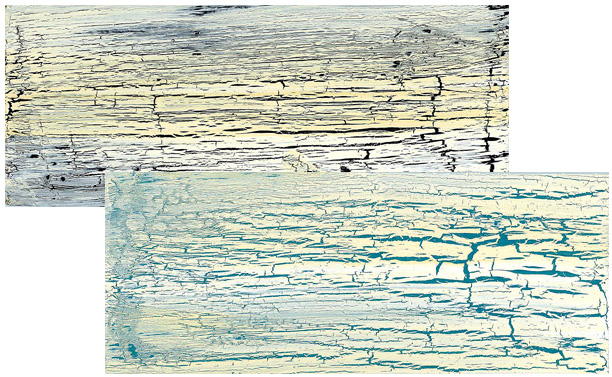How To Make A Clear Crackle Finish

Of all the expensive, hard to manage supplies I've come across, crackle finish wins as both ridiculously costly, and annoyingly unreliable. When I first heard of crackle finishes being done with consistently good results, and with a cost effective medium, I was dubious. I was wrong. You really can get a great crackle finish on cardstock, chipboard, wood and even fabric using—-wait for it—-Elmer's Glue All, which costs less than a dollar for a 4 oz. bottle if you hit a back to school sale.
To make your crackle finish, you'll need:
- Elmer's Glue All white glue. This technique may work with other white glues, but I haven't tried them. I do know it doesn't work with Tacky Glue.
- Acrylic paints. I used the cheap stuff, as always, because I wanted to let some of the base coat show through the top coat. You'll need two colors. For my samples, I used teal and black as base coats, and a mix of white and yellow ochre for the top coat.
- A wide bristle brush, an old credit card, or scrap of chipboard.
- A surface. I did my samples on cardstock and wood. I've seen this done on muslin, too.
This is a technique you'll want to test, on a surface similar to what you want to crackle. Results may vary widely, due to surface choice, paint viscosity, and weather conditions.


Let the base coat dry completely. This is very important.


Let the glue dry until it's just tacky.



And the results? Here we go:

Glue applied vertically, with a brush.
Top coat applied horizontally, with a brush.

Glue applied horizontally, with a credit card.
Top coat applied horizontally, with a brush.

Glue applied horizontally, with a credit card.
Top coat applied horizontally, with a brush.

Glue applied vertically, with a brush.
Top coat applied horizontally, with a brush.

Glue applied horizontally, with a credit card.
Top coat applied horizontally.

Glue applied horizontally, with a credit card.
Top coat applied horizontally.
How To Make A Clear Crackle Finish
Source: https://mixedmedia.club/make-your-own-crackle-finish/
Posted by: goldmanvizing.blogspot.com

0 Response to "How To Make A Clear Crackle Finish"
Post a Comment